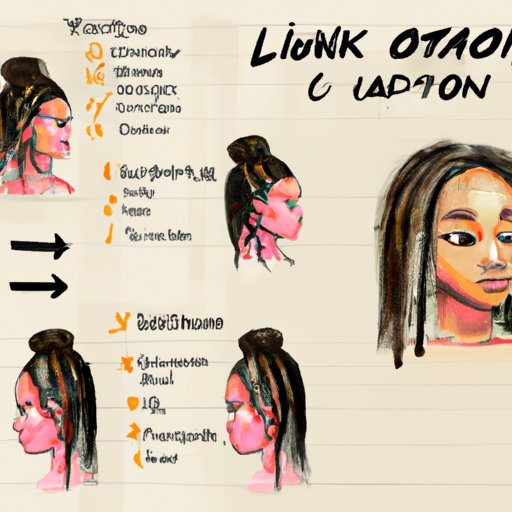
Introduction
Locs, also known as dreadlocks, are a unique and popular African-American hairstyle. Drawing locs can be a challenging but rewarding experience for artists. This article will provide a comprehensive guide on how to draw locs, including basic tips, step-by-step instructions, advanced techniques, and common mistakes to avoid. The article will also cover different loc styles and tips for drawing locs on people with varying hair textures and styles.
A Step-by-Step Guide to Drawing Locs
Before we dive into how to draw locs, it’s important to have some basic tips for getting started. These tips will help you create realistic and textured locs.
Start with a rough outline of the hair shape, then start drawing individual locs from the root. Use light, curved lines to create the shape of the locs, then darken them gradually to add texture.
For more advanced techniques, try cross hatching and using different pencil strokes to create added depth and texture.
Here are the step-by-step instructions for drawing locs:
- Start by drawing the outline of the hair shape.
- Draw individual locs from the root up using light, curved lines.
- Gradually darken the locs to add texture and depth.
- Add shading to create further texture.
- Use crosshatching and different pencil strokes to create added depth and texture.
These steps will help you create realistic and textured locs.
Tips and Tricks for Better Locs
To create better locs, it’s important to choose the right materials, develop shading techniques, and add dimension through highlights and shadows.
Choosing the right pencil is crucial. A softer pencil, such as a 2B or 4B, is ideal for creating texture and shading. Avoid using a hard pencil, as it will create stiff lines that won’t look natural.
When shading locs, start with a light layer of graphite and gradually darken the layer to add depth. Use soft, circular motions to create the shape of the locs and add shading.
Adding dimension to locs can be achieved through highlights and shadows. Use white pencil or ink to add highlights to the locs, and dark pencil or ink to create shadows.
An Overview of Different Loc Styles
There are different styles of locs, each with their own unique characteristics. The most popular loc styles are:
Traditional dreadlocks
The traditional way of creating locs involves letting the hair naturally mat and lock without using any styling tools. These locs can vary in size and shape, depending on the individual’s hair texture and length.
Sisterlocks
Sisterlocks are similar to traditional dreadlocks, but they are smaller and require the use of a special tool to create them. They are popular with people who have thinner hair or want a more manicured look.
Twists
Twists are similar to locs, but they are created by twisting two sections of hair together instead of letting the hair naturally mat and lock. This style is popular for people who have shorter hair or want a less permanent solution.
Different styles of locs may require different techniques for drawing them. For example, traditional dreadlocks may require more crosshatching and shading to create a textured appearance, while sisterlocks may require more attention to detail to create the individual strands that make up each loc.
Common Mistakes to Avoid
When drawing locs, there are common mistakes to avoid that can make your drawings look stiff or unrealistic.
- Drawing locs too stiffly or rigidly
- Not achieving the right texture for locs
- Not paying attention to shading and highlights
By following the tips and techniques in this article, you can avoid these mistakes and create realistic and textured locs.
Drawing Locs on Different People
Locs can be drawn on people with varying hair textures and styles, but there may be some challenges in doing so.
For people with thinner or shorter hair, it may be harder to create the texture and depth required for realistic and textured locs. You may need to work with smaller strokes or focus more on shading to create the appearance of texture.
For people with thicker or longer hair, creating the individual strands that make up each loc can be a challenge. It’s important to pay attention to detail and create each strand with care.
The History of Locs and How to Draw Them
Locs have a significant cultural and historical significance. For people with African-American ancestry, locs have been used as a symbol of pride and cultural identity.
When drawing locs, it’s important to portray them accurately and respectfully. Understanding the cultural and historical significance of locs can help you create a more meaningful and impactful drawing.
Conclusion
Drawing locs can be a fun and rewarding experience for artists. By following the tips and instructions in this article, you can create realistic and textured locs. Remember to choose the right materials, pay attention to shading and highlights, and understand the cultural significance of locs. With practice and patience, you can master the art of drawing locs.




